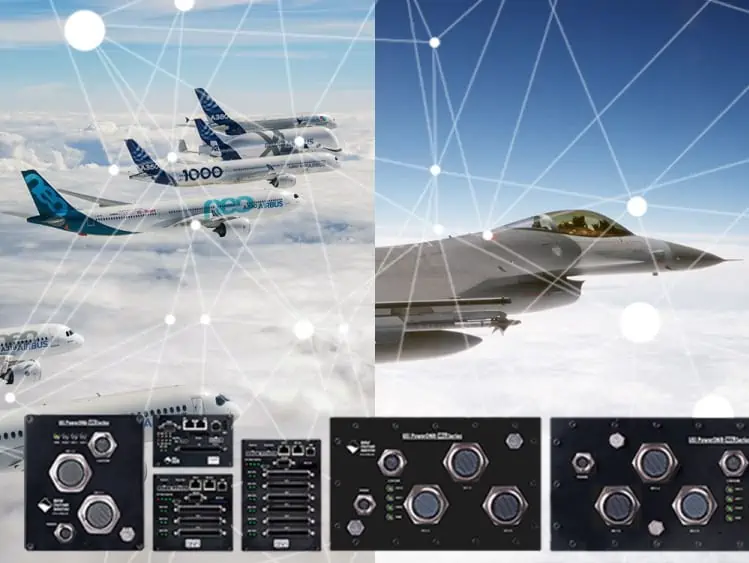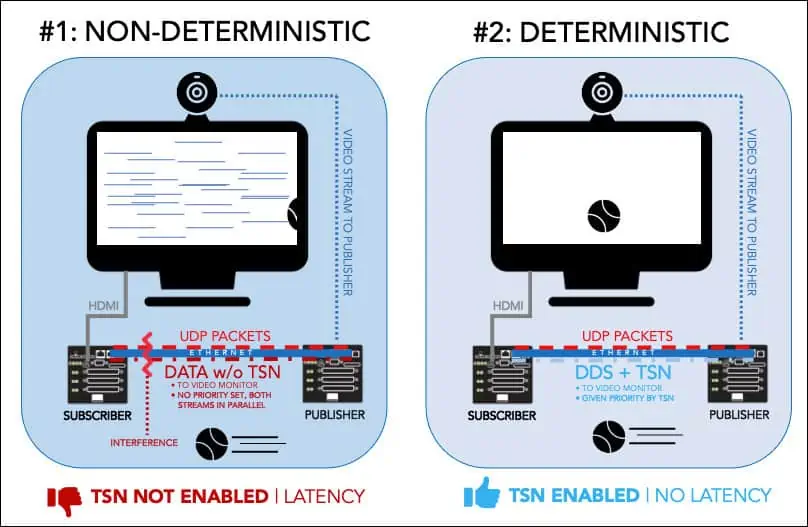
United Electronic Industries (UEI) has released the following article explaining how the combination of Time Sensitive Networking (TSN) and Data Distribution Services (DDS) enable the design of interconnected systems, such as UAVs and robotic vehicles, with Quality of Service (QoS) for critical data flows.
We live in a world of unmanned aerial vehicles and other complex military systems. These interconnected systems deploy multiple sensors, computers, and actuators operating at scales that challenge network communication flow. To enable such automation, avionics systems require deterministic communication within a specific, predictable period-of-time, along with access to guaranteed, precisely timed system control.
That’s where Time Sensitive Networking (TSN) – combined with Data Distribution Services (DDS) – comes into play. It takes deterministic communication to the next logical step, enabling engineers to design distributed avionic systems that specify and enforce Quality of Service (QoS) for critical data flows.
TSN is a lower-level (Layer 2) network technology for real-time applications that requires predictable behavior. It provides deterministic packet delivery over standard Ethernet, and centrally manages the network resources to enable bounded jitter and latency, and guaranteed bandwidth on a network.
DDS is the real-time, highly scalable communications standard that sits on top of the TSN communication layer. DDS is implemented as a software layer that sits close to the application and provides an open API and Protocol to enable QoS-aware communications, enabling determinism, reliability, scalability, and availability.
Used together, TSN and DDS work to enable deterministic communications in distributed systems using standards-based, commercially available technologies. TSN and DDS enable real-time connectivity to predictably function in lossy and unstable network environments. For mission-critical systems, this provides guaranteed communications with QoS across complex, fast-moving systems. Even if you have a lot of other traffic on your network, your critical DDS communications are unaffected.
This combination ensures network traffic prioritization capabilities via QoS. For example, critical messages – such as data about a system failure – is prioritized over less critical communication, such as one frame in a video feed.
UEI is the US-based provider of rugged and reliable hardware for aerospace and defense data acquisition, test, and control systems. UEI has teamed with RTI, the leader in DDS technology, to provide a combined TSN – DDS solution for avionics connectivity needs. The TSN – DDS offering brings the powerful features of RTI Connext – QoS, scalability, reliability, powerful configuration, and diagnostic tools – to the TSN layer in a way that guarantees bandwidth for DDS traffic. In mission-critical systems, this communications reliability results in a safer, robust, and more reliable system.
In the highlighted demonstration video and infographic, we showcase how using User Datagram Protocol (UDP) and DDS with TSN determinism delivers priority data without delay.
System #1 shows a UEI SoloX ARM publisher chassis connected to a UEI SoloX ARM subscriber chassis via Ethernet. This time, the publisher is sending the video stream from the web camera to the subscriber over RTI Connext without TSN enabled with an additional UDP packet stream (no packet priority set and video stream lags).
System #2 uses the same setup of a UEI SoloX ARM publisher chassis connected to a UEI SoloX ARM subscriber chassis via Ethernet. The publisher is sending a video stream from a web camera to the subscriber over RTI Connext with TSN enabled with an additional UDP packet stream (network traffic showcases TSN determinism).
UDP-ONLY SYSTEM #1 RESULTS:
UDP is running with multiple streaming processes, active interference bottlenecks, and with no TSN priority enabled, the image delivery is severely delayed with the potential to create a high volume of image pixelation. UDP on its own will continuously push all data from the publisher with no preference to priority. When mission critical data delivery is of the utmost importance, solely relying on UDP can be a costly, and even deadly, solution.
TSN-ENABLED SYSTEM #2 RESULTS:
Video stream is set to the highest priority, when an image moves directly in front of the camera, the monitor displays the image movement in real-time without any latency. TSN determinism ensures that even with multiple processes running simultaneously, prioritized data will be delivered without interruption, preventing non-real-time traffic from interfering with deterministic real-time data.
The importance of TSN determinism cannot be overstated, as critical message delivery without latency over high-speed and complex data systems is a must for modern avionics applications. UEI’s ARM processing power, ruggedness, chassis flexibility, and breath of I/O allow for a wide variety of TSN applications. Combined with RTI Connext QoS, scalability, and reliability software tools, high traffic mission-critical systems are guaranteed uninterrupted and enable deterministic delivery of critical DDS communications.











